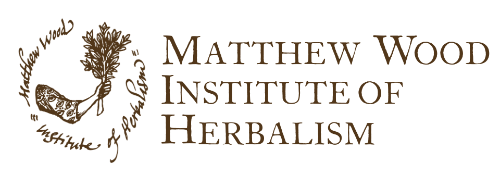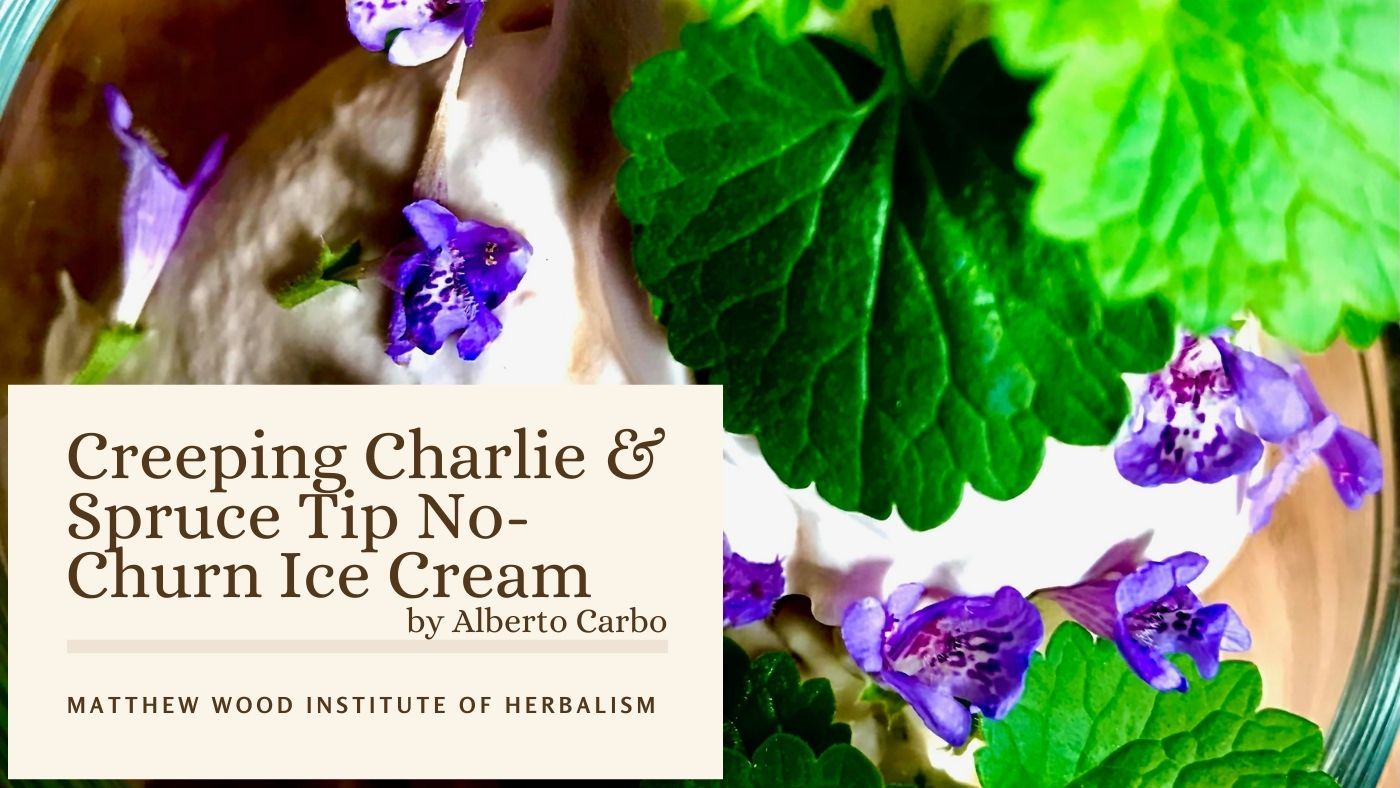Jump to Recipe
Creeping Charlie - Glechoma hederaceae, is a wonderful cousin of the mint, or Lamiaceae family (look for its square stem). Reminiscent of Catnip, Creeping Charlie exudes a skunky bitterness in the background of the minty aroma and palate at the forefront. I love using it in salads, stir frys, omelets, crème Fraiche, on strawberries, and so many other ways.
Although it was brought to North America from Europe for its culinary and medicinal characteristics, Creeping Charlie is naturalized now and can be easily found. It is a perennial that spreads through seed dispersal as well as through root division, easily propagating. Although popularly used for medicinal purposes in the past, it has fallen out of use contemporarily.
Creeping Charlie is an alterative, adept at gradually re-invigorating the eliminative channels of the body, encouraging the elimination of metabolic accumulations while simultaneously improving the assimilation of nutrients. The Doctrine of Signatures helps us appreciate the kidney-shaped leaves, indicating Creeping Charlie’s ability to improve the quality of the blood by supporting the function of the kidneys.
From its bitter taste, we know that Creeping Charlie supports the actions of the liver, which is constantly busy filtering and cleansing the blood.
Matthew Wood, MS, have used it specifically for virulent infections of the middle ears, or with any chronic respiratory congestion that originated with a blockage of the Eustachian tubes. In line with its ability to support the body's eliminative abilities, Glechoma is also an adept remedy and preventative for lead poisoning, and potentially other heavy metals such as mercury.
------------------------
For a while now, I have been fascinated by the way in which many evergreens grow in the spring. Not only do the budding branches look adorable, but they are also delicious, and their flavor profile is certainly befitting an early edible – zingy/citrusy, piney, and resinous aftertaste which is stimulating to the system. Spruce tips are also rich in vitamin C, potassium, magnesium, carotenoids, and chlorophyll. For a long time, these magical tassel-like growths have been used by indigenous peoples of North America to relieve coughs and sore throats, usually in the form of infusion.
As many spring plants do, and many conifers, spruce tips encourage the expectoration of stale leftover mucus from winter, while revitalizing and invigorating the lungs.
Ideally, you would want to harvest these when they are still young and tender, many will still have their papery casings around them. They are so delicious, and unique in flavor, that it is hard to refrain from constantly eating as you collect them.
------------------------
Taking the shortcut doesn’t always work out! I found this was the case for ice cream for the longest time, and although I absolutely love ice cream, I found that making it at home was a time-demanding endeavor that I would, unfortunately, make much less frequently than I had romanticized.
One day, purely by chance, I discovered that there is a simple way to make ice cream. A much quicker way. It takes a little planning ahead, but minimal time in the kitchen. Now I make ice cream much more often!
A few easy steps, a little planning ahead, and you’ve got ice cream! No ice cream machine is necessary. This is a simple cooling recipe, that comes in handy as the temperatures get hotter. The cream lends itself well to the Creeping Charlie and Spruce tip infusion, as the velvety cream picks up on the skunky minty-ness of the Creeping Charlie and the citrusy resin-like aromas of the Spruce tips.
Although it was brought to North America from Europe for its culinary and medicinal characteristics, Creeping Charlie is naturalized now and can be easily found. It is a perennial that spreads through seed dispersal as well as through root division, easily propagating. Although popularly used for medicinal purposes in the past, it has fallen out of use contemporarily.
Creeping Charlie is an alterative, adept at gradually re-invigorating the eliminative channels of the body, encouraging the elimination of metabolic accumulations while simultaneously improving the assimilation of nutrients. The Doctrine of Signatures helps us appreciate the kidney-shaped leaves, indicating Creeping Charlie’s ability to improve the quality of the blood by supporting the function of the kidneys.
From its bitter taste, we know that Creeping Charlie supports the actions of the liver, which is constantly busy filtering and cleansing the blood.
Matthew Wood, MS, have used it specifically for virulent infections of the middle ears, or with any chronic respiratory congestion that originated with a blockage of the Eustachian tubes. In line with its ability to support the body's eliminative abilities, Glechoma is also an adept remedy and preventative for lead poisoning, and potentially other heavy metals such as mercury.
------------------------
For a while now, I have been fascinated by the way in which many evergreens grow in the spring. Not only do the budding branches look adorable, but they are also delicious, and their flavor profile is certainly befitting an early edible – zingy/citrusy, piney, and resinous aftertaste which is stimulating to the system. Spruce tips are also rich in vitamin C, potassium, magnesium, carotenoids, and chlorophyll. For a long time, these magical tassel-like growths have been used by indigenous peoples of North America to relieve coughs and sore throats, usually in the form of infusion.
As many spring plants do, and many conifers, spruce tips encourage the expectoration of stale leftover mucus from winter, while revitalizing and invigorating the lungs.
Ideally, you would want to harvest these when they are still young and tender, many will still have their papery casings around them. They are so delicious, and unique in flavor, that it is hard to refrain from constantly eating as you collect them.
------------------------
Taking the shortcut doesn’t always work out! I found this was the case for ice cream for the longest time, and although I absolutely love ice cream, I found that making it at home was a time-demanding endeavor that I would, unfortunately, make much less frequently than I had romanticized.
One day, purely by chance, I discovered that there is a simple way to make ice cream. A much quicker way. It takes a little planning ahead, but minimal time in the kitchen. Now I make ice cream much more often!
A few easy steps, a little planning ahead, and you’ve got ice cream! No ice cream machine is necessary. This is a simple cooling recipe, that comes in handy as the temperatures get hotter. The cream lends itself well to the Creeping Charlie and Spruce tip infusion, as the velvety cream picks up on the skunky minty-ness of the Creeping Charlie and the citrusy resin-like aromas of the Spruce tips.
Creeping Charlie & Spruce Tip No-Churn Ice Cream
As always make sure to forage for plants away from roads and pollution as much as possible. Never overharvest any plant, as they are of course not only here for our enjoyment, but also here for the insects, bees, and birds. Have fun out there!
**Permissions**
You’re welcome to share this blog post on social media and link back to it—please do! All images, photos, and written content are the creative property of the author and used with permission. If you’d like to reproduce or distribute any part of this content beyond social sharing, written permission is required.
**Disclaimer**
The information provided in this digital content is for educational purposes only and is not intended as medical advice, diagnosis, or treatment. It should not be used as a substitute for consultation with a qualified healthcare professional. Always consult a licensed healthcare provider before making any changes to your health regimen, especially if you are pregnant, nursing, taking medications, or have a diagnosed medical condition.
Matthew Wood, the Matthew Wood Institute of Herbalism, Earth to Stars Productions, and their employees, guests, affiliates, and collaborators assume no liability for the use or misuse of any information presented. The application of any material is solely the responsibility of the reader or participant.
Any descriptions of herbal or natural products, remedies, or techniques are for informational purposes only. These statements have not been evaluated by the Food and Drug Administration (FDA). This content is not intended to diagnose, treat, cure, or prevent any disease.
Participation in educational programs or use of this material does not confer certification, licensure, or professional qualification in herbal medicine or any healthcare field. Results or experiences described may vary and are not guaranteed.
This disclaimer shall be governed by and construed in accordance with the laws of Minnesota, USA, without regard to conflict of law principles.


